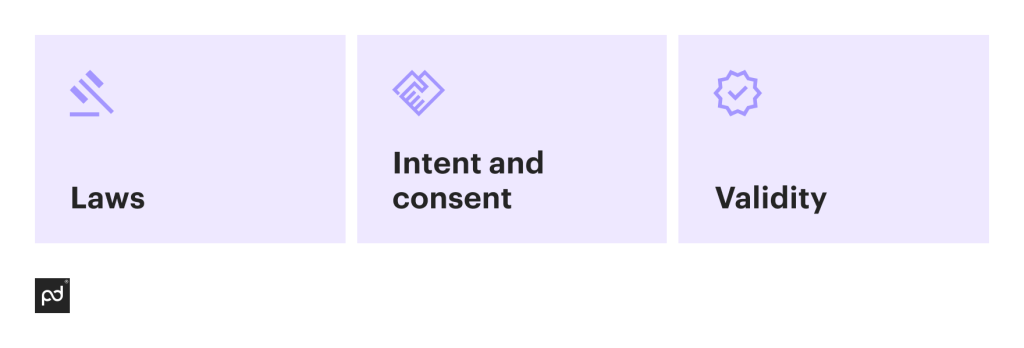Electronic signatures are commonplace in most business operations.
They reduce delays, speed up workflows, and allow organizations to reduce administrative burdens.
This is possible because, in most scenarios, electronic signatures are legally binding.
Read on to learn more about the legal framework surrounding e-signatures and how digital signing has been used to replace most handwritten signatures.
Key takeaways
- Electronic signatures are legally binding and enforceable in the US, the European Union, and many other countries.
- A variety of technology solutions exist to ensure the signer’s identity and the validity of the signed document.
- Electronic signatures may not be considered valid in certain legal scenarios, including matters of family law or estate planning. Restrictions vary by jurisdiction.
What makes electronic signatures legal?
Electronic signatures are considered legally valid in many countries around the world.
As such, there is no single, governing document that identifies e-signatures as a valid and legal way to sign documents. Instead, a collection of federal laws and state laws comprise the e-signature landscape that we know today.
However, while e-signature laws are as complex and varied as their use cases, there are a few commonalities that make authentication and enforceability possible:

Laws
All jurisdictions where e-signatures are legal have some legal framework to enshrine that legality.
Often, these regulations exist at both a federal and state or provincial level.
Intent and consent
In every scenario, both signers must intend to and consent to sign electronically. An electronic signature is only considered valid as long as both conditions are true.
Validity
The e-signature must be considered valid and compliant with the legal requirements for an e-signature. While this varies slightly across regions, such requirements almost always include the ability to verify the identity of the signer and ensure the integrity of the document.
In the following sections, we’ll cover each of these elements in greater detail.
However, keep in mind that the laws covering specific jurisdictions will vary.
If you have specific questions about a signed contract or a valid use of electronic signatures on a unique, electronic document, consider seeking advice from a legal professional.
What types of documents can be signed using electronic signatures?
While there are some exceptions, most modern business documents and consent forms can be signed using electronic signatures.
This includes but is not limited to the following examples:
- Contracts and agreements.
- Invoices and purchase orders.
- Releases and waivers.
- Non-disclosure agreements.
- Non-compete agreements.
- Employment contracts.
- Leasing agreements.
- Mortgage documents.
However, keep in mind that the ability to use electronic signatures may vary by region.
Some areas of law — particularly in family law and estate planning — may require a wet signature.
If you’re uncertain whether electronic signatures are allowed as legally binding tender on a specific document, consider a consultation with a legal professional.
Why should I use electronic signatures?
Aside from their legally binding nature, electronic signatures are also beneficial in each of the following ways:
Reduces paper costs and administrative workloads
Electronic signatures eliminate the need to print, scan, and mail documents, which can save businesses a significant amount of money on paper and postage.
They also reduce the need for manual data entry, which can lower costs and investment on administrative tasks.
Improves and expedites document workflows
Electronic signatures can help businesses to streamline their document workflows by making it easier and faster to get documents signed.
This can lead to reduced processing times and improved customer satisfaction.
Allows for document automation, resulting in fewer errors
Electronic signatures can be used to automate document workflows, which helps to reduce the number of errors that are made in the document preparation.
Improves transaction velocity and deal ROI
E-signature functionality can help businesses close deals faster by making it easier for customers to sign documents.
Increases overall document security
Electronic signatures can help to improve the security of documents by making it more difficult for unauthorized individuals to tamper with or forge them.
For an in-depth explanation on each of these benefits, check out this article on the benefits of electronic signing.
Laws governing electronic signatures
The laws governing electronic signatures vary by country and by region.
When creating legal documents for use in these jurisdictions, it can be beneficial to familiarize yourself with the requirements for the electronic signing process.
Alternatively, it’s faster and easier to use an e-signature software — such as PandaDoc, DocuSign, or Adobe Sign — that can ensure compliance throughout the signature process.
United States
In the US, a handful of independent documents ensure that e-signatures provide the appropriate legal weight.
The Uniform Electronic Transactions Act (UETA) describes electronic signatures as:
“…an electronic sound, symbol, or process attached to or logically associated with a record and executed or adopted by a person with the intent to sign the record.”
A variety of other documents also play a role in further defining the legal effects surrounding electronic records. These are:
- Electronic Signatures in Global and National Commerce Act (E-SIGN ACT).
- FDA Electronic Signature Regulations.
- Electronic Signatures and Records Act (ESRA)*.
- Uniform Commercial Code (UCC).
*Quick note: ESRA is defined in New York state law rather than laws at a federal level and guarantees that electronic signatures are equal to paper signatures. However, due to the commercial influence generated by New York City, this law has a nationwide impact on electronic signature regulations.
European Union
By contrast, the European Union recently consolidated the majority of its electronic signature compliance under the eIDAS Regulation.
This regulation sets out a legal framework that can be used to create valid e-signatures across all member nations while also greatly clarifying the types of electronic signatures that can be considered valid (more on this below).
In all, the eIDAS may seem more approachable because it’s a single document. However, be aware that it can be just as unwieldy as the conglomeration of documents utilized across the US market.
Other nations
While US and EU regulations largely define the e-signature landscape, other countries have similar legal frameworks and documentation in place.
For example, Canada’s electronic signature laws are covered by the Personal Protection and Electronic Documents Act (PIPEDA), while the United Kingdom still complies with the eIDAS Regulation despite their exit from the EU in 2021.
To learn more about the various electronic signature laws governing each country, take a closer look at our resources on electronic signature law.
What is the difference between electronic signature & digital signatures?
Simply put, a digital signature is a type of electronic signature.
Per the Uniform Electronic Transactions Act (UETA), an electronic signature might be described as:
“…an electronic sound, symbol, or process attached to or logically associated with a record and executed or adopted by a person with the intent to sign the record.”
On the other hand, a digital signature relies on digital technology tools and protocols to securely identify all signatories and protect the integrity of the signed document.
Digital signatures often use sophisticated encryption methods, digital certificates of authenticity, audit trails, and more to create an authentic e-signature that is very difficult to dispute.
To learn more about these differences, check out this article.
Is it legal to notarize an electronic signature?
The legal landscape for e-signature notarization varies by state laws.
The notarization of an electronic signature requires that both document signatories electronically sign the document in front of a seated and commissioned notary public.
This is most commonly done through a remote online notarization (RON) service. However, this process is not yet recognized in some US states.
Types of electronic signatures
As mentioned above, the eIDAS Regulation classifies electronic signatures into one of three distinct categories.
These categories also share some similarities and overlaps with e-signature types defined in US law, but the eIDAS system offers a better classification:

Simple e-signatures
Simple e-signatures are broadly defined by the law as a form of data that you use to sign something. For example, saying, “I agree” or replying with a “thumbs up” could be counted as a simple e-signature under certain conditions.
Advanced/digital signatures
Advanced/digital signatures use digital technology to verify the sender, signer, and document. These signatures are the modern standard for legal documents like business contracts and usually require specialized e-signature software to create and are equivalent to handwritten signatures in the US and many other parts of the world.
Qualified electronic signatures
Qualified electronic signatures are the most secure type of e-signature and are only available in the EU. Qualified electronic signatures are legally equivalent to handwritten signatures (EU only) and must be created using specialized devices and certified software.
For further reading on the types of e-signatures, check out this knowledge article on the different types of e-signatures and which signature type you should use.
Should my digital signature look like my “wet ink” signature?
It is true that you can use online tools and signing platforms to create a “wet ink” or handwritten facsimile of your online signature. However, this is not necessary to create an authentic digital signature.
For example, PandaDoc allows signatories to sign documents by drawing their signature, typing their name, or uploading an image of their handwritten signature.
All signing methods, combined with our secure, digital verification process, can be used to create a certified electronic signature.
This is common among most e-signature solutions.
The digital signature generated when you sign a document is created using a combination of cryptographic data and personalized information.
When signing an electronic form, an e-signature provider will capture each of the following element to verify the identity of the signer:
- Name and email address.
- IP address.
- Device fingerprint.
- Signature (handwritten, typed, or image).
- Timestamp and date of signature.
This data is captured within a secure connection generated by a certificate authority using public key infrastructure (PKI).
The e-signature solution issues one private key per signer, typically through a unique access link sent via email.
After this attribution data is confirmed, a Trust Services Provider will issue a certificate of authenticity, guaranteeing the validity of the signature.
While the security process can be intimidating, all of this happens in the background when using e-signature apps.
From the signer’s perspective, everything happens with just a few taps or clicks.
Validity and nonrepudiation
One of the key factors in determining the legality of an e-signature is the ability to prove its authenticity and validity.
This is called nonrepudiation: the assurance that the authenticity of a digital signature cannot be denied.
While nonrepudiation methods are not always legally required, many e-signature providers offer these tools to add further evidence of authenticity to their document process.
Here are a few common methods used to guarantee signer and/or document authenticity:
- Audit trails track activity on the document, including who viewed the document and how often it was accessed.
- Versioning keeps track of document history, including when documents are changed or dispatched for signature.
- Tamper-proof signing workflows lock the document when the signing process is initiated to prevent further changes.
- Digital certificates of completion show the signer’s IP address, email address, and the date/time of signature capture.
- Document storage tools assist with records retention and preservation of signed contracts.
While many of these features are designed to prove that a document is authentic, they may also be useful for handling other aspects of document workflows.
For example, audit trails can play a major role in the creation of document analytics that help teams better determine which proposals are most effective.
Likewise, many legal jurisdictions require that a signed contract be reproducible in the event of a legal challenge.
Document storage tools ensure that you have access to the contract should such a challenge arise.
When are e-signatures rendered invalid?
Typically, e-signatures are rendered invalid over disputes of authenticity.
If a signer denies that they ever signed a document (or claims that they never intended to sign a document), the authenticity of the signature and its attached contract may be drawn into question.
In the event that the intent to sign and the authenticity of the signature aren’t proven, a signature may be rendered invalid.
For this reason, many e-signing platforms offer various ways to authenticate the identity of the signer while also taking steps to ensure the integrity of the signed document.
Get secure, valid signatures with PandaDoc
While electronic signatures are legal, acquiring a digital signature that can stand up to scrutiny in a court of law can be somewhat challenging.
Working with an e-signing platform like PandaDoc can help to minimize the possibility of legal disputes and ensure the validity of your contracts while streamlining your entire signing workflow.
In addition to a smooth signing process, we offer native integrations with top CRMs like Salesforce or Microsoft Dynamics, as well as productivity tools like Slack or Google Workspace to connect your signing process to the rest of your tech stack.
Want to learn more?
Sign up for a free 14-day trial or request a personalized demo and see for yourself how legally binding digital signatures can change how you do business.
Disclaimer
PandaDoc is not a law firm, or a substitute for an attorney or law firm. This page is not intended to and does not provide legal advice. Should you have legal questions on the validity of e-signatures or digital signatures and the enforceability thereof, please consult with an attorney or law firm. Use of PandaDocs services are governed by our Terms of Use and Privacy Policy.


